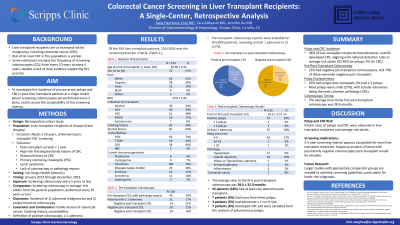Sunday Poster Session
Category: Colorectal Cancer Prevention
P0435 - Colorectal Cancer Screening in Liver Transplant Recipients: A Single Center, Retrospective Analysis
Sunday, October 27, 2024
3:30 PM - 7:00 PM ET
Location: Exhibit Hall E

Has Audio

Sang Hee K. Choi, MD
Scripps Clinic
San Diego, CA
Presenting Author(s)
Sang Hee Choi, MD1, Tara Alleyasin, MD2, Jennifer Au, MD3
1Scripps Clinic, San Diego, CA; 2Scripps Clinic, La Jolla, CA; 3Scripps Health, San Diego, CA
Introduction: Solid organ transplant recipients are at increased risk for various malignancies, including colorectal cancer (CRC). However, the risk of de novo CRC in this population is unclear. Some institutions increase screening colonoscopy frequency from every 10 years to every 5 years, despite the lack of clear evidence supporting this practice. This study investigates the incidence of precancerous polyps and CRC in post-transplant patients at a single center, where screening colonoscopies are performed every 5 years, to assess the necessity of this interval.
Methods: We retrospectively reviewed liver transplant recipients between January 2013 and December 2023 at a single center. Patients with post-transplant survival < 1-year, first-degree family history of CRC, personal history of CRC, primary sclerosing cholangitis, Lynch syndrome, or lack of colonoscopy/pathology reports were excluded.
Results: Of the 359 liver transplant patients, 126 met the inclusion criteria. The mean age at transplant was 57.0 ± 9.2 years; 64% were white, 49% had a smoking history, and 64% had a history of alcohol use. Indications for liver transplant included alcohol-induced cirrhosis (24%), Hepatitis C (39%), hepatocellular carcinoma (48%), and metabolic dysfunction-associated steatohepatitis cirrhosis (15%). Immunosuppression was predominantly managed with Tacrolimus (79%), Mycophenolate mofetil (36%), Sirolimus (17%), Everolimus (10%), and other agents (11%).
Pre-transplant colonoscopy reports were available for 49 (39%) patients, revealing at least 1 adenoma in 21 (17%). The average time to the first post-transplant colonoscopy was 38.6 ± 32.9 months; 35 (28%) patients had at least 1 adenoma post-transplant, and 7 (6%) developed CRC, thus excluded from the analysis. Additionally, 7 (6%) patients had more than 3 polyps, and 3 (3%) had adenomas ≥ 1 cm. Among 28 patients with negative pre-transplant colonoscopy, 20 (71%) remained adenoma-free post-transplant.
Discussion: The incidence of precancerous polyps in liver transplant recipients at this single center (28%) is comparable to the national detection rate in average-risk adults (20-30%). The CRC incidence (6%) also mirrors that of average-risk adults (4%). These findings suggest a 5-year screening interval is more than appropriate for most liver transplant recipients, and certain subgroups might benefit from less frequent screening. Further studies with larger multicenter cohorts are necessary to refine screening guidelines for this population.
Disclosures:
Sang Hee Choi, MD1, Tara Alleyasin, MD2, Jennifer Au, MD3. P0435 - Colorectal Cancer Screening in Liver Transplant Recipients: A Single Center, Retrospective Analysis, ACG 2024 Annual Scientific Meeting Abstracts. Philadelphia, PA: American College of Gastroenterology.
1Scripps Clinic, San Diego, CA; 2Scripps Clinic, La Jolla, CA; 3Scripps Health, San Diego, CA
Introduction: Solid organ transplant recipients are at increased risk for various malignancies, including colorectal cancer (CRC). However, the risk of de novo CRC in this population is unclear. Some institutions increase screening colonoscopy frequency from every 10 years to every 5 years, despite the lack of clear evidence supporting this practice. This study investigates the incidence of precancerous polyps and CRC in post-transplant patients at a single center, where screening colonoscopies are performed every 5 years, to assess the necessity of this interval.
Methods: We retrospectively reviewed liver transplant recipients between January 2013 and December 2023 at a single center. Patients with post-transplant survival < 1-year, first-degree family history of CRC, personal history of CRC, primary sclerosing cholangitis, Lynch syndrome, or lack of colonoscopy/pathology reports were excluded.
Results: Of the 359 liver transplant patients, 126 met the inclusion criteria. The mean age at transplant was 57.0 ± 9.2 years; 64% were white, 49% had a smoking history, and 64% had a history of alcohol use. Indications for liver transplant included alcohol-induced cirrhosis (24%), Hepatitis C (39%), hepatocellular carcinoma (48%), and metabolic dysfunction-associated steatohepatitis cirrhosis (15%). Immunosuppression was predominantly managed with Tacrolimus (79%), Mycophenolate mofetil (36%), Sirolimus (17%), Everolimus (10%), and other agents (11%).
Pre-transplant colonoscopy reports were available for 49 (39%) patients, revealing at least 1 adenoma in 21 (17%). The average time to the first post-transplant colonoscopy was 38.6 ± 32.9 months; 35 (28%) patients had at least 1 adenoma post-transplant, and 7 (6%) developed CRC, thus excluded from the analysis. Additionally, 7 (6%) patients had more than 3 polyps, and 3 (3%) had adenomas ≥ 1 cm. Among 28 patients with negative pre-transplant colonoscopy, 20 (71%) remained adenoma-free post-transplant.
Discussion: The incidence of precancerous polyps in liver transplant recipients at this single center (28%) is comparable to the national detection rate in average-risk adults (20-30%). The CRC incidence (6%) also mirrors that of average-risk adults (4%). These findings suggest a 5-year screening interval is more than appropriate for most liver transplant recipients, and certain subgroups might benefit from less frequent screening. Further studies with larger multicenter cohorts are necessary to refine screening guidelines for this population.
Disclosures:
Sang Hee Choi indicated no relevant financial relationships.
Tara Alleyasin indicated no relevant financial relationships.
Jennifer Au indicated no relevant financial relationships.
Sang Hee Choi, MD1, Tara Alleyasin, MD2, Jennifer Au, MD3. P0435 - Colorectal Cancer Screening in Liver Transplant Recipients: A Single Center, Retrospective Analysis, ACG 2024 Annual Scientific Meeting Abstracts. Philadelphia, PA: American College of Gastroenterology.

